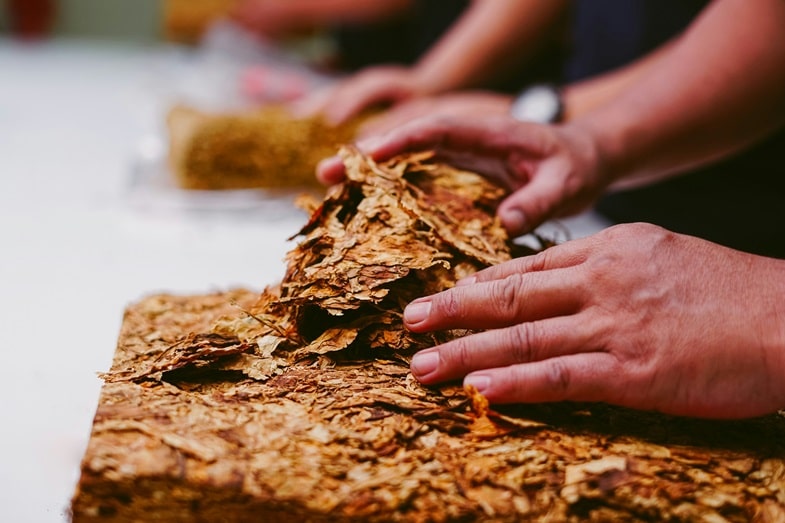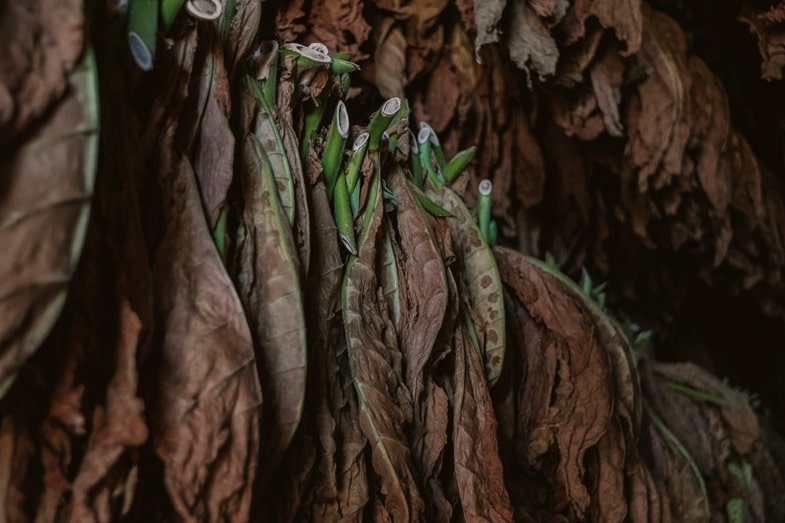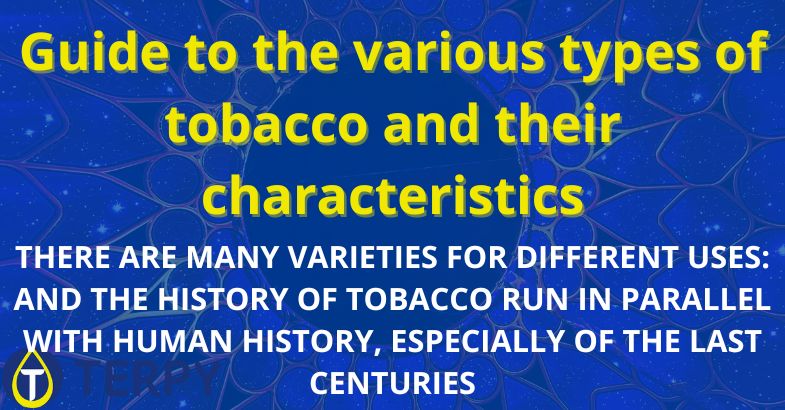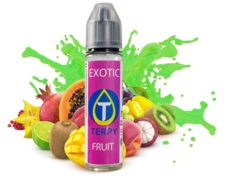Published on: 10/04/2024
THERE ARE MANY VARIETIES FOR DIFFERENT USES: AND THE HISTORY OF TOBACCO RUN IN PARALLEL WITH HUMAN HISTORY, ESPECIALLY OF THE LAST CENTURIES
In the world of cultivated plants, tobacco is one of the most influential yet controversial crops in human history. Its origin dates back to ancient times, when indigenous civilizations in the Americas used the plant for recreational, ritual and medicinal purposes. With the arrival of European peoples in the New World, tobacco crossed the ocean and became an economic and cultural factor similar to coffee and chocolate.
An economic factor, however, is at the basis of an extremely harmful vice for health, which still today causes the death of millions of people around the world. But which, fortunately, can be fought thanks to powerful weapons such as electronic cigarettes, one of the least harmful alternatives available today, as we often repeat here on Terpy.
Despite this negative aspect, however, it is legitimate to be intrigued by tobacco, its history and its variety.
Would you like to know more?
We tell you everything in this article.
Read also: Exvapo 2024: program and details on the vaping fair in Naples
Brief history of tobacco
The history of tobacco is linked above all to the colonization of America. Already in 1609, John Rolfe, one of the first English settlers in Virginia, introduced the cultivation of Nicotiana tabacum, a variety of tobacco more appreciated by European consumers than the local species Nicotiana Rustica. This act marked the birth of an industry that became one of the cornerstones of the colonial economy: the need for labor would have significant historical consequences, including the sad reality of the exploitation of African slaves.
Over time, tobacco has evolved: from cultivation it has become a symbol of luxury and status, while the consequences of consumption on health have raised numerous ethical and legal debates, controversies and restrictions, influencing global public health policies and social habits. .
Despite the undoubted negative health consequences, tobacco continues to be a valuable commercial product, with specific varieties imparting unique characteristics to products such as cigarettes, cigars and pipe tobacco.


What are the main tobacco varieties?
The variety and complexity of tobacco crops are surprising: each variety has characteristics linked to its genetics, cultivation method and manufacturing process.
Let’s start with the Habano 2000, a cross between the Habano and the Corojo. Primarily intended for the production of cigarettes, Habano 2000 is known for its balance between robustness and aromaticity, making it a favorite among manufacturers of high-quality cigarettes.
Maduro, on the other hand, rather than a specific type of tobacco, is a fermentation process that applies to different varieties. This process involves exposing the leaves to high temperatures and a high level of humidity: the tobacco thus acquires a sweeter and richer flavor. Maduro is appreciated by cigar lovers for its intense flavor and unique texture.
Nicotiana rustica is an indigenous variety of the southwestern United States, Mexico and parts of South America. Known for its strength, this variety is often used in powder form or as a pesticide. Its robustness makes it less suitable for direct consumption.
Finally, Turkish (Oriental) is a group of varieties that evolved from the first importations of Nicotiana Tabacum into Turkey. These tobaccos are grown in a band that goes from southern Italy to the Balkans, up to Ukraine and southern Russia. Their aromatic qualities are obtained from poorly developed plants with smaller leaves at the top, and require special care. Production is limited, but the quality is high.
Each of these types of tobacco, with their unique characteristics, influences the quality and taste of the finished products and tells stories of cultures, traditions and agricultural innovations.
Tobacco: the specific characteristics of the different varieties
Exploring the specific characteristics of the different types of tobacco means immersing yourself in a world of aromatic nuances and “structural” differences.
Habano 2000, for example, has an excellent balance between strength and aroma, and a robustness that is reflected in a rich flavor and uniform combustion: it is used for high-end cigarettes.
The production process of Maduro, however, gives this quality of tobacco a unique flavor profile. Fermentation in conditions of high temperature and humidity gives the leaves a sweet and deep taste, with notes of chocolate and coffee that make it particularly appreciated by cigar lovers.
Nicotiana rustica has a remarkably high nicotine content, which makes it “strong”, especially suitable for alternative uses in the form of natural pesticides or in specific mixtures.
Varieties such as Izmir and Samsun of the “Turkish” group are appreciated for their small leaves which offer a delicate and refined taste: grown in less fertile soils, they are famous for their aromatic properties. Their limited production and the meticulous care required in cultivation and processing make them among the most valuable in the tobacco panorama.
The specific characteristics of each type of tobacco, from genetics to processing, play a crucial role in determining the sensorial experience of the finished product. Whether it’s the robustness of Habano 2000, the sweetness of Maduro, the power of wild tobacco, or the delicate aroma of Turco, each variety has something unique to offer.
The method of cultivation and processing of tobacco
The tobacco cultivation and processing processes require meticulous attention and specialized techniques which influence the quality and characteristics of the final product.
Tobacco cultivation begins with planting. Initial growth in seedbeds requires well-nourished soil, enriched with ash and manure, and a protected environment. After development, the seedlings are transplanted into the fields.
Once transplanted, tobacco plants require constant care to protect them from pests and diseases. The harvesting of tobacco leaves varies depending on the variety: some are harvested leaf by leaf, others are harvested entirely.
After harvesting, the leaves undergo a drying and fermentation process. The drying technique changes depending on the type of tobacco: some varieties are dried in the sun, others by fire, and still others by hot air. This process reduces the moisture content in the leaf, concentrating the flavors and aromas.
Fermentation is another important phase: the leaves, piled up, are fermented under controlled conditions, a process that can vary from a few weeks to several months, and even years, depending on the type of tobacco and the desired flavor. Fermentation serves to reduce acidity and develop aromatic complexity in the leaves.
Tobacco cultivation and processing methods influence the characteristics of each variety. These processes, which combine tradition and innovation, are what makes tobacco such a varied product, different from quality to quality.
Use of different qualities of tobacco
Tobacco, with its wide range of varieties and characteristics, is used in diverse ways, demonstrating its versatility beyond the traditional confines of smoking.
One of the best-known applications of tobacco is in the production of cigarettes. Several varieties, such as Habano 2000, are particularly prized for their strength and aroma, providing a solid foundation for high-quality cigarette blends. Likewise, Maduro, with its sweet and rich taste, is mainly used for premium cigars.
In addition to cigarettes and cigars, tobacco is also used in pipe blends. Here, the variety and complexity of the blends can vary: some tobaccos have light aromatic notes, while others add depth and richness to the blend. The ability to mix different strains allows you to create a wide range of smoking experiences.
Less known is the use of tobacco in perfumery. Some varieties of tobacco, thanks to their natural aromatic notes, have been selected as notes for men’s perfumes.
Additionally, wild tobacco, such as Nicotiana rustica, is used as a natural pesticide, taking advantage of its robust properties and high nicotine content.
Even the tobacco liquids for electronic cigarettes, which you can find in our store, are inspired by the aroma of tobacco to satisfy the needs of vapers who are most fond of the taste of this plant.
Whether cigarettes, cigars, pipe blends, or even perfumes, tobacco proves to be a versatile crop, whose cultural and economic impact extends across diverse industries and practices


Tobacco in history: commercial and economic aspects
Tobacco, as a crop and as a commercial product, still plays a significant role in the global economy, influencing not only the consumer goods market, but also agricultural, trade and public health policies.
Historically, tobacco was one of the main drivers of the colonial economy, particularly in the Americas, where European demand for this product stimulated highly developed agricultural and commercial activity. This demand led to the creation of vast plantations, whose labor was unfortunately provided by the exploitation of slaves. This link between tobacco and slavery has left a complicated legacy, which has negatively influenced the socio-economic structures of the societies involved.
In the modern era, tobacco continues to be an economically important crop, and the tobacco industry is a source of tax revenue for many governments. The economic aspect, however, must not overshadow the sacrosanct public health concerns linked to tobacco consumption, which have led to a series of severe behavioral, legal and fiscal restrictions in many countries.
The tobacco market has also seen notable changes over the years, with an increasing focus on product diversification. In addition to traditional cigars and cigarettes, new forms of consumption have emerged, such as vaporization products (the vaping we know well).
Read also: World Vape Day: how the day dedicated to vapers was born and what it consists of
In conclusion
From this analysis of the varieties, history, cultivation methods and characteristics of tobacco, a complex and multifaceted picture emerges. Tobacco, a plant with deep roots in human history and culture, continues to be a product of great economic importance, despite its main use, cigarette, cigar and pipe smoking, being responsible for many serious diseases, which is why many smokers prefer to switch to vaping, which is decidedly less harmful.
We have seen how different varieties of tobacco bring with them a history and unique characteristics, which influence the quality and type of products in which they are used. This diversity is a testimony to the cultural and agronomic richness linked to tobacco. At the same time, cultivation and processing methods, ranging from traditional to modern techniques, reflect the continuous evolution of the sector in response to environmental and economic challenges.
In short, tobacco still has a certain importance as a crop and commercial product, but the complex public health and political issues related to its consumption make it one of the most controversial crops. It is no coincidence that the growing awareness of the health risks associated with tobacco has led to significant changes in consumer habits and government policies.
If our article has satisfied your curiosity, discover all the other contents of Terpy’s blog. And if you too have entered the world of vaping to abandon cigarettes and reduce the damage caused by smoking, don’t forget to take a look at our store: from electronic cigarettes to vaping liquids, up to concentrated aromas and to liquid nicotine, on Terpy you will find everything a vaper like you needs!
Takeaways
Tobacco has an ancient history, with roots in the indigenous civilizations of the Americas, but gained significant importance with the arrival of European colonizers in the New World. This gave rise to an industry that had a similar economic and cultural impact to coffee and chocolate.
Despite its controversial role in human health, e-cigarettes are considered one of the least harmful options compared to traditional tobacco, offering an alternative for those who wish to reduce the risks associated with smoking.
Tobacco varieties are surprisingly different, each with its own characteristics based on genetics, cultivation method and manufacturing process. For example, Habano 2000 is known for its balance between robustness and aromaticity, while Maduro is renowned for its sweet and rich flavor.
The tobacco cultivation and processing processes require great attention and specialized techniques. From seedlings to drying and fermentation stages, each step affects the quality of the tobacco and its unique flavor.
Tobacco is used in a variety of ways, from making high-quality cigarettes and cigars to pipe blends. It can even be used in perfumery and as a natural pesticide. This versatility makes tobacco a plant grown for a wide range of purposes.
Questions & answers
How did tobacco arrive in Europe?
The history of tobacco is mainly linked to the colonization of the Americas and its diffusion in Europe. The indigenous civilizations of the Americas used it for recreational, ritual and medicinal purposes. With the arrival of European colonizers, tobacco became an important economic product, but also a source of controversy and ethical debates due to its harmful effects on health.
What are the main varieties of tobacco?
There are several varieties of tobacco, including Habano 2000, Maduro, Nicotiana rustica and Turkish. Each variety has unique characteristics related to its genetics, cultivation method and manufacturing process, influencing the taste and quality of the finished products.
How is tobacco used?
Tobacco is used in a variety of ways, including the production of cigarettes, cigars, pipe blends, and perfumes. Some varieties are prized for producing high-quality cigarettes, while others are used for premium cigars. Tobacco is also used as a natural pesticide and is used in e-cigarette liquids.










